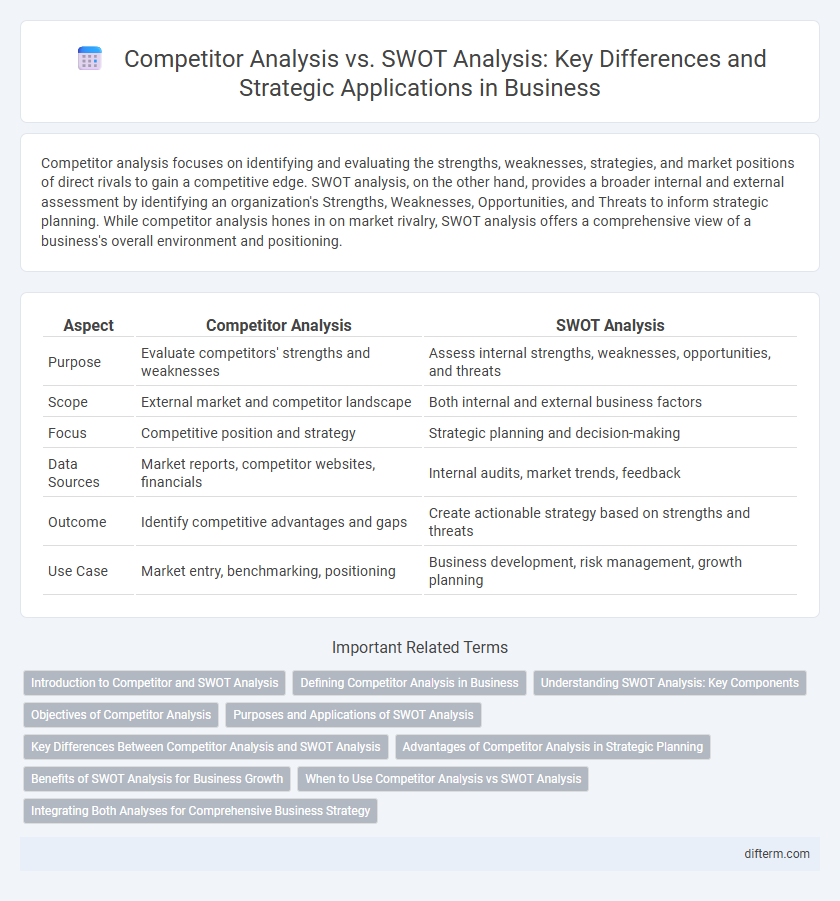Competitor analysis focuses on identifying and evaluating the strengths, weaknesses, strategies, and market positions of direct rivals to gain a competitive edge. SWOT analysis, on the other hand, provides a broader internal and external assessment by identifying an organization's Strengths, Weaknesses, Opportunities, and Threats to inform strategic planning. While competitor analysis hones in on market rivalry, SWOT analysis offers a comprehensive view of a business's overall environment and positioning.
Table of Comparison
| Aspect | Competitor Analysis | SWOT Analysis |
|---|---|---|
| Purpose | Evaluate competitors' strengths and weaknesses | Assess internal strengths, weaknesses, opportunities, and threats |
| Scope | External market and competitor landscape | Both internal and external business factors |
| Focus | Competitive position and strategy | Strategic planning and decision-making |
| Data Sources | Market reports, competitor websites, financials | Internal audits, market trends, feedback |
| Outcome | Identify competitive advantages and gaps | Create actionable strategy based on strengths and threats |
| Use Case | Market entry, benchmarking, positioning | Business development, risk management, growth planning |
Introduction to Competitor and SWOT Analysis
Competitor analysis identifies key market players, evaluates their strengths, weaknesses, strategies, and market positioning to highlight opportunities and threats. SWOT analysis assesses an organization's internal strengths and weaknesses alongside external opportunities and threats to inform strategic decision-making. Combining competitor analysis with SWOT analysis provides a comprehensive view of competitive dynamics and internal capabilities for effective business strategy development.
Defining Competitor Analysis in Business
Competitor analysis in business involves systematically evaluating competitors' strengths, weaknesses, strategies, and market positioning to identify opportunities and threats. It provides actionable insights that help companies refine marketing tactics, improve product offerings, and enhance competitive advantage. Unlike SWOT analysis, which covers internal and external factors broadly, competitor analysis specifically targets understanding rivals within the industry landscape.
Understanding SWOT Analysis: Key Components
SWOT Analysis identifies internal strengths and weaknesses alongside external opportunities and threats, enabling businesses to strategically assess their market position. Key components include evaluating resources, organizational capabilities, market trends, and competitor dynamics to inform decision-making. This analysis aids in uncovering competitive advantages and potential risks, guiding effective strategy development and resource allocation.
Objectives of Competitor Analysis
Competitor analysis aims to identify key market players, evaluate their strengths and weaknesses, and uncover opportunities to outperform rivals. It focuses on gathering actionable intelligence about competitors' strategies, product offerings, market positioning, and customer base to enhance strategic decision-making. By understanding competitive dynamics, businesses can develop targeted marketing plans, improve product development, and anticipate market trends effectively.
Purposes and Applications of SWOT Analysis
SWOT analysis serves to identify internal strengths and weaknesses alongside external opportunities and threats, enabling businesses to develop strategic plans that leverage competitive advantages and mitigate risks. It is applied in decision-making processes, market positioning, and resource allocation to enhance organizational performance. Unlike competitor analysis, which focuses specifically on evaluating rivals, SWOT analysis provides a comprehensive framework for assessing overall business environment and internal capabilities.
Key Differences Between Competitor Analysis and SWOT Analysis
Competitor analysis focuses specifically on evaluating rival companies' strengths, weaknesses, market positioning, and strategies to identify opportunities and threats relative to direct competitors. SWOT analysis provides a broader overview by assessing an organization's internal strengths and weaknesses alongside external opportunities and threats, encompassing market conditions beyond competitors alone. The key difference lies in competitor analysis targeting competitive landscape insights, whereas SWOT analysis offers a comprehensive strategic framework integrating both internal and external factors.
Advantages of Competitor Analysis in Strategic Planning
Competitor analysis provides precise insights into market positioning by evaluating rivals' strengths, weaknesses, strategies, and customer responses, enabling informed decision-making in strategic planning. It uncovers direct competitive threats and market trends that SWOT analysis might overlook due to its broader internal-external focus. Utilizing competitor analysis enhances the ability to anticipate competitor moves, optimize resource allocation, and identify opportunities for differentiation and growth.
Benefits of SWOT Analysis for Business Growth
SWOT Analysis identifies internal strengths and weaknesses alongside external opportunities and threats, enabling businesses to make strategic decisions that drive sustainable growth. This comprehensive framework helps companies align resources and capabilities to market demands, improving competitive positioning. By revealing actionable insights, SWOT Analysis supports risk management and capitalizes on emerging trends to enhance business expansion.
When to Use Competitor Analysis vs SWOT Analysis
Competitor analysis is essential when businesses need to understand market positioning, identify direct competitors' strengths and weaknesses, and develop strategies to outperform rivals. SWOT analysis is most effective during strategic planning phases to assess internal capabilities and external opportunities or threats, providing a comprehensive overview beyond just competition. Choose competitor analysis for tactical market insights and SWOT analysis for broader organizational evaluation and long-term planning.
Integrating Both Analyses for Comprehensive Business Strategy
Integrating competitor analysis with SWOT analysis creates a comprehensive business strategy by leveraging external market insights alongside internal strengths and weaknesses. Competitor analysis identifies industry positioning, market trends, and competitor capabilities, while SWOT analysis contextualizes these factors within the company's resources and challenges. Combining both approaches enables businesses to make informed strategic decisions, optimize competitive advantages, and proactively address potential threats.
Competitor Analysis vs SWOT Analysis Infographic

 difterm.com
difterm.com